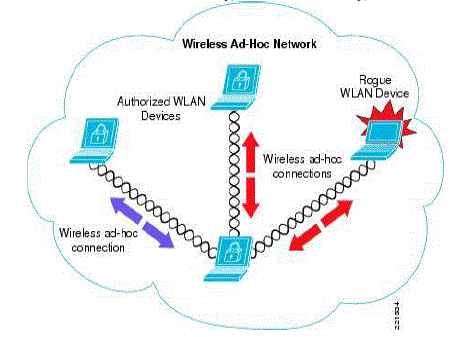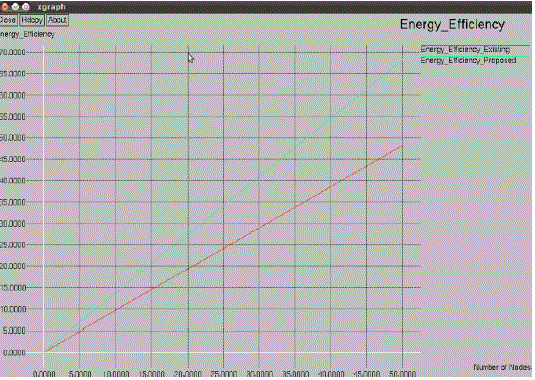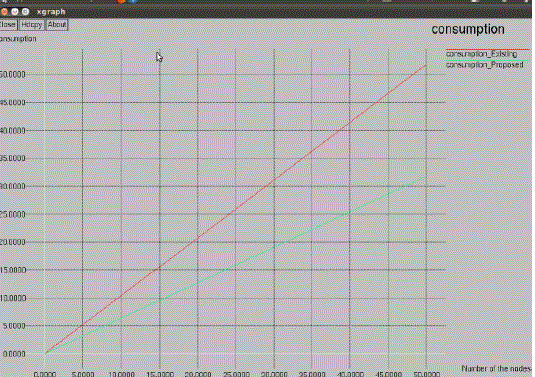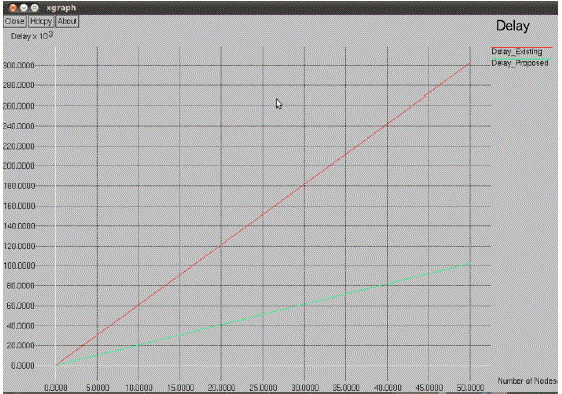Keywords
|
| ERMECR , WANET , MDR , MAC |
INTRODUCTION
|
| A wireless ad hoc network (WANET) is a decentralized type of wireless network. The network is ad hoc because it does not rely on a pre existing infrastructure, such as routers in wired networks or access points in managed (infrastructure) wireless networks. Instead, each node participates in routing by forwarding data for other nodes, so the determination of which nodes forward data is made dynamically on the basis of network connectivity. In addition to the classic routing, ad hoc networks can use flooding for forwarding data. |
| An ad hoc network typically refers to any set of networks where all devices have equal status on a network and are free to associate with any other ad hoc network device in link range. Ad hoc network often refers to a mode of operation of IEEE 802.11 wireless networks. The earliest wireless ad hoc networks were the "packet radio" (PRNETs) sponsored by DARPA after ALOHA net project. |
RELATED WORK
|
| In [1] author dealt with Multi-access protocol for Ad Hoc networks that conserves power by turning off radios under certain conditions. In this paper, power savings range from 10% to 70% in fully connected networks. It achieves the power savings without affecting the delay or throughput behavior of the basic protocol. In [2] author discussed the need to make routing protocols power aware. Using Traditional metrics such as hop count or delay for finding routes.This is more important to use cost/packet and maximum node cost. In this paper’s simulation work demonstrated that significant reductions in cost can be obtained by using shortest cost routing as opposed to shortest hop routing. In [3] author have shown, Why the effective total transmission energy, which includes the energy spent in potential retransmissions. The proper metric for reliable, energy efficient communications. The energy efficiency of a candidate route is thus critically dependent on the packet error rate of the underlying links, As part of future research, authors intend to extend our analyses (which assumed each link to be operating independently of other links) to scenarios, such as IEEE 802.11-based networks, where the logical links share the same physical channel and hence, interfere with one another. Indeed, since an energy-aware routing protocol defines the next-hop node (and hence, implicitly defines the associated transmission power), the choice of the routing algorithm is expected to affect both the overall network capacity and individual session throughputs in such scenarios. In [4] author propose a new metric, the drain rate, to forecast the lifetime of nodes according to current traffic conditions. This metric is combined with the value of the remaining battery capacity to determine which nodes can be part of an active route. It describe new route selection mechanisms for MANET routing protocols, which call the Minimum Drain Rate (MDR) and the Conditional Minimum Drain Rate (CMDR). MDR extends nodal battery life and the duration of paths, while CMDR also minimizes the total transmission energy consumed per packet. Using the ns-2 simulator and the dynamic source routing (DSR) protocol, to compare MDR and CMDR against prior proposals for energy-aware routing and show that using the drain rate for energy-aware route selection offers superior performance results. Methods keywords are system design and simulations. |
| The lifetime maximization problem is NP-hard. [5] authors are also have proposed a new online heuristic– OML–for lifetime maximization. Extensive simulations show that the new heuristic is superior to previously published heuristics for lifetime maximization both in terms of providing larger lifetime and in terms of sensitivity to algorithm parameters .Additionally, The proposed heuristic provides larger network capacity than provided by competing heuristics. The problem of minimum energy routing for reliable one-to-one communication in the presence of lossy links. [6] The author solved the problem in the hop-by-hop retransmission model, where each link is assumed to support link layer hop-by-hop retransmission and guarantee reliable delivery. In [7] , author have examined the energy cost metrics widely used in the existing energy efficient routing protocols, and developed more accurate energy consumption models for common MAC protocols CSMA, MACA, and 802.11. Unlike existing models that ignored energy consumption due to various control messages and thus underestimated the actual energy cost, in models take into account such energy consumption. The accuracy of models have been verified through simulations. More specifically, energy consumption models developed for both the EER and HHR modes have been shown to be much closer to the actual energy consumed than the existing models. In [8] author demonstrated the feasibility as well as potential benefits of data-driven routing by designing protocol LOF. LOF mainly used three techniques for link quality estimation and route selection: initial sampling, data-driven adaptation, and exploratory neighbor sampling. With its well-tested performance and implementation, LOF has been successfully used to support converge cast in the backbone network of Excels |
PROPOSED ALGORITHM
|
| A. Description of the Proposed Algorithm: |
| The formal description of the Energy based reliable minimum energy cost routing (ERMECR) Energy-aware routing algorithm, called Energy based reliable minimum energy cost routing (ERMECR). ERMECR finds energyefficient and reliable routes that increase the operational lifetime of the network. In the design of ERMECR, an indepth and detailed analytical model of the energy consumption of nodes has been designed. |
| ERMECR is proposed for networks with hop-by-hop (HBH) retransmissions providing link layer reliability, and networks with E2E retransmissions providing E2E reliability. HBH retransmission is supported by the medium access control (MAC) layer (more precisely the data link layer) to increase reliability of packet transmission over wireless links.MAC protocols such as CSMA and MACA may not support HBH retransmissions. Two sets of energyaware reliable routing algorithms for HBH and E2E systems. In ERMER, energy cost of a path for EtoE packet traversal is the expected amount of energy consumed by all nodes to transfer the packet to the destination. In ERMECR, the energy cost of a path is the expected battery cost of nodes along the path to transfer packet from the source to the destination. |
PSEUDO CODE
|
| Step 1 : Node Deployment(ni) |
| Step 2 : Set the Energy level to all the nodes. (Ei) |
| Step 3 : Select the Source(S) and Destination(D) nodes |
| Step 4 : To select the Intermediater (I) based on minimum distance(d) and the high Energy(HE) |
| Step 5 : Data Transmission from S to D. |
| Step 6 : To calculate the Energy Efficiency(Ef) |
| Step 7 : To calculate the Energy Consumption(Ec) |
| Step 8 : End. |
SIMULATION RESULTS
|
| The simulation analysis for ERMECR while the data transmission and certificate revocation based security is implemented using Network Simulator NS2 |
| The simulation is done for Energy Efficiency , Energy consumption and Delay using ERMECR whose results are shown in Figure 1 , 2 & 3 respectively. |
| The above figure shows that the Energy efficiency of the proposed system is better than the existing system |
| The figure 2 shows that the Energy consumption of the proposed system is lesser than the existing system. |
| The figure 3 shows that the Delay of the proposed system is lesser than the existing system. |
CONCLUSION AND FUTURE WORK
|
| An in-depth study of energy-aware routing in ad hoc networks has been analyzed, and a new routing algorithm has been proposed for wireless ad hoc networks, namely, Energy Based Reliable minimum energy cost routing (ERMECR). ERMECR can increase the operational lifetime of the network using energy-efficient and reliable routes. In the design of ERMECR, a detailed energy consumption model used for packet transfer in wireless ad hoc networks. ERMECR improves the efficiency, consumption and reduces the delay from the existing System. The algorithm may be enhanced in order to reduce the overhead. |
Figures at a glance
|
 |
 |
 |
 |
| Figure 1 |
Figure 2 |
Figure 3 |
Figure 4 |
|
References
|
- S. Singh and C. Raghavendra, ?PAMAS—Power Aware Multi- Access Protocol with Signalling for Ad Hoc Networks,? ACMComputer Communication , vol. 28 issue no 4, pp. 5-26, 1999.
- S. Singh, M. Woo, and C.S. Raghavendra, ?Power-Aware Routing in Mobile Ad Hoc Networks,? Proc. ACM Mobile Communication,pp 102-105, Oct. 1998.
- S. Banerjee and A. Misra, ?Minimum Energy Paths for Reliable Communication in Multi-Hop Wireless Networks,? Proc. ACMMobile Hoc, pp. 46-156, June 2002.
- D. Kim, J.J.G. Luna Aceves, K. Obraczka, J. Carlos Cano, and P. Manzoni, ?Routing Mechanisms for Mobile Ad Hoc NetworksBased on the Energy Drain Rate,? IEEE Transactions on Mobile Computing, vol. 2, issue no. 2, pp. 161-173, Apr.-June 2003.
- J.-H. Chang and L. Tassiulas, ?Maximum Lifetime Routing in Wireless Sensor Networks,? IEEE/ACM Trans. Networking, vol. 12, issue no. 4, pp. 609-619, Aug. 2004.
- Q. Dong, S. Banerjee, M. Adler, and A. Misra, ?Minimum Energy Reliable Paths Using Unreliable Wireless Links,? Proc. ACMMobile Hoc, pp. 449-459, May 2005.
- J. Zhu, C. Qiao, and X. Wang, ?On Accurate Energy Consumption Models for Wireless Ad Hoc Networks,? IEEE Trans. WirelessComm., vol. 5, issue no. 11, pp. 3077-3086, Nov. 2006.
- H. Zhang, A. Arora, and P. Sinha, ?Link Estimation and Routing in Sensor Network Backbones: Beacon-Based or Data-Driven??IEEE Trans. Mobile Computing, vol. 8, issue no. 5, pp. 653-667, May 2008
|